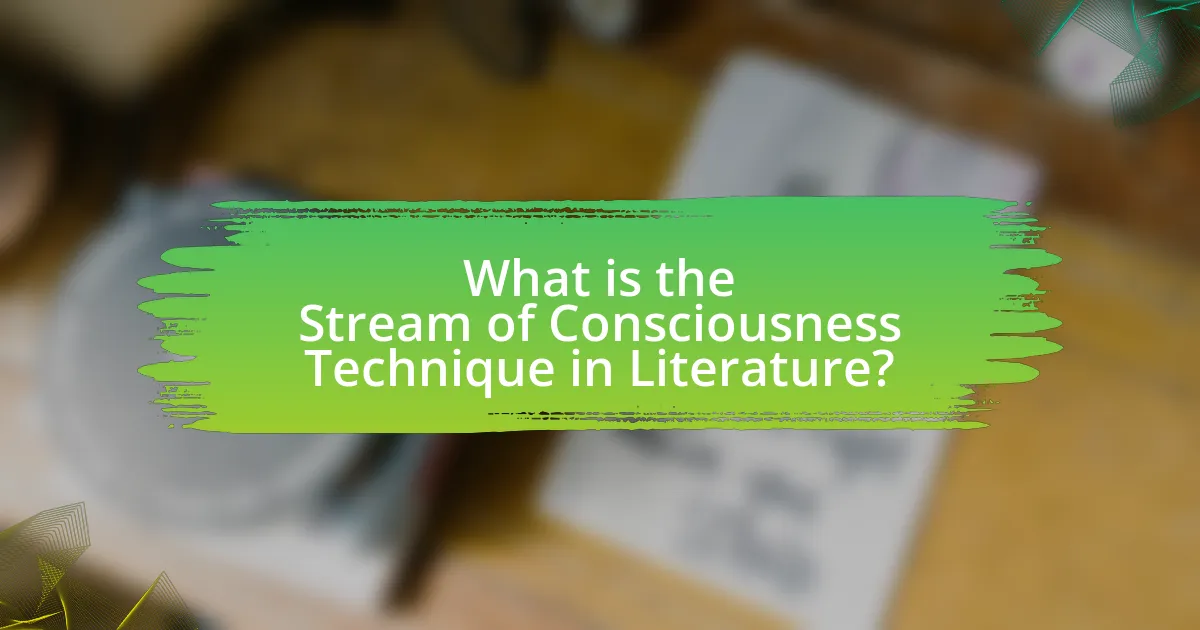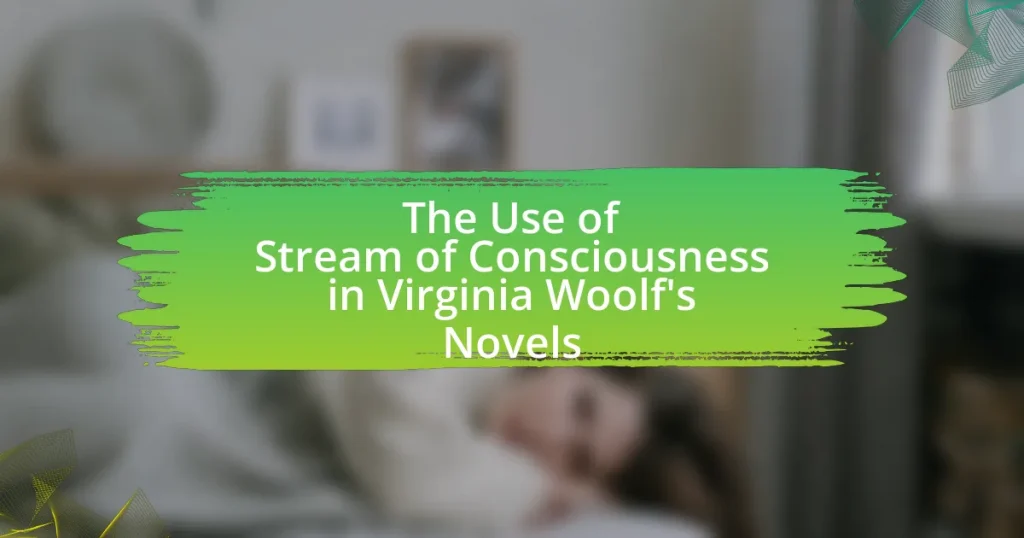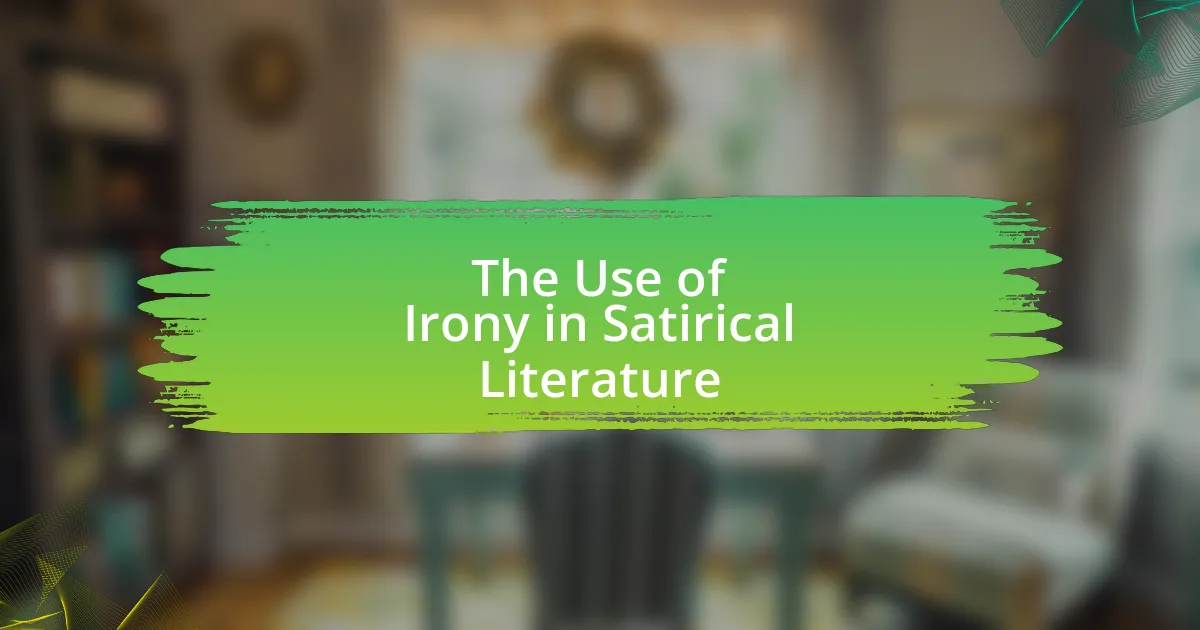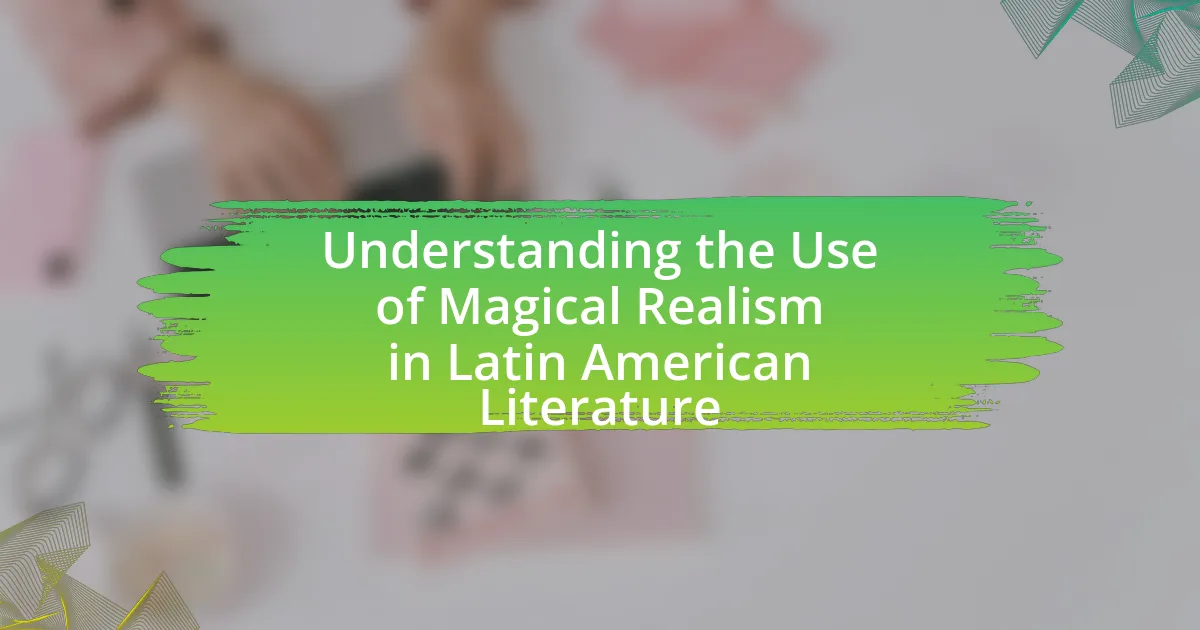The article focuses on the Stream of Consciousness technique as utilized in Virginia Woolf’s novels, highlighting its significance in capturing the flow of thoughts and emotions within characters’ minds. It explores the evolution of this narrative method from the late 19th century to its prominence in modern literature, particularly through the works of Woolf and James Joyce. Key characteristics of the technique, such as non-linear narrative structure and free association, are discussed, along with its impact on character development, reader engagement, and thematic depth. The article also examines how Woolf’s personal experiences influence her narrative style and the portrayal of identity, memory, and self-awareness in her works.

What is the Stream of Consciousness Technique in Literature?
The Stream of Consciousness Technique in literature is a narrative method that attempts to capture the flow of thoughts and feelings in a character’s mind. This technique often employs a continuous flow of ideas, sensory experiences, and emotions, reflecting the natural thought processes of individuals. Notably, authors like Virginia Woolf and James Joyce utilized this technique to provide deeper psychological insight into their characters, allowing readers to experience their inner lives in a more intimate and immediate way. Woolf’s works, such as “Mrs. Dalloway” and “To the Lighthouse,” exemplify this technique by blending narrative and character consciousness seamlessly, illustrating the complexity of human thought and perception.
How did the Stream of Consciousness technique evolve over time?
The Stream of Consciousness technique evolved from early narrative forms in the late 19th century to a prominent literary style in the early 20th century, particularly through the works of authors like James Joyce and Virginia Woolf. Initially, the technique was characterized by a focus on the inner thoughts and feelings of characters, as seen in the writings of authors such as Marcel Proust, who utilized it to explore memory and perception. As the technique developed, it became more experimental, with Joyce’s “Ulysses” showcasing a complex interplay of thoughts and sensory experiences, while Woolf further refined it in novels like “Mrs. Dalloway” and “To the Lighthouse,” emphasizing the fluidity of consciousness and the subjective experience of time. This evolution marked a shift in narrative style, allowing for deeper psychological exploration and a departure from traditional linear storytelling.
What are the key characteristics of the Stream of Consciousness technique?
The key characteristics of the Stream of Consciousness technique include a focus on the inner thoughts and feelings of characters, a non-linear narrative structure, and the use of free association. This technique allows authors to depict the continuous flow of a character’s thoughts, often blending sensory perceptions, memories, and emotions without traditional punctuation or structure. Virginia Woolf, a prominent user of this technique, exemplifies these characteristics in her novels, such as “Mrs. Dalloway” and “To the Lighthouse,” where she captures the complexities of human consciousness and the passage of time through fragmented and associative prose.
How does Stream of Consciousness differ from traditional narrative styles?
Stream of Consciousness differs from traditional narrative styles by prioritizing the inner thoughts and feelings of characters over structured plot development. Traditional narratives typically follow a linear progression with clear exposition, rising action, climax, and resolution, while Stream of Consciousness presents a more fragmented and non-linear exploration of a character’s psyche. This technique allows for a deeper psychological insight, as seen in Virginia Woolf’s works, where characters’ thoughts flow freely, often reflecting their emotional states and perceptions in real-time, rather than adhering to conventional storytelling methods.
Why is Stream of Consciousness significant in modern literature?
Stream of Consciousness is significant in modern literature because it captures the inner thoughts and feelings of characters in a way that reflects the complexity of human consciousness. This narrative technique allows authors to present a more authentic and nuanced portrayal of characters’ experiences, as seen in the works of Virginia Woolf, who utilized this style to explore themes of time, identity, and perception. Woolf’s novels, such as “Mrs. Dalloway” and “To the Lighthouse,” exemplify how Stream of Consciousness can convey the fluidity of thought and the interconnectedness of moments, thereby influencing the development of modernist literature and expanding the boundaries of narrative form.
What impact has Stream of Consciousness had on character development?
Stream of Consciousness has significantly deepened character development in Virginia Woolf’s novels by providing an intimate glimpse into characters’ thoughts and emotions. This narrative technique allows readers to experience the fluidity of consciousness, revealing the complexities of characters like Clarissa Dalloway and Septimus Warren Smith in “Mrs. Dalloway.” Woolf’s use of this style enables a nuanced exploration of their inner lives, showcasing their psychological struggles and existential reflections. For instance, the technique captures the fragmented nature of Clarissa’s thoughts, illustrating her memories and perceptions in real-time, which enhances the reader’s understanding of her character and motivations. This method of character portrayal has influenced modern literature by emphasizing the importance of internal monologue in conveying psychological depth.
How does Stream of Consciousness influence reader engagement?
Stream of Consciousness enhances reader engagement by immersing readers in the characters’ thoughts and emotions, creating a deeper connection to their experiences. This narrative technique allows readers to experience the flow of thoughts in real-time, fostering empathy and understanding of the characters’ inner lives. For instance, in Virginia Woolf’s “Mrs. Dalloway,” the use of Stream of Consciousness reveals Clarissa Dalloway’s complex feelings about her past and present, drawing readers into her psychological landscape. This method not only captures the immediacy of human thought but also encourages readers to actively participate in interpreting the narrative, thereby increasing their engagement with the text.
How is Stream of Consciousness utilized in Virginia Woolf’s Novels?
Stream of Consciousness is utilized in Virginia Woolf’s novels to depict the inner thoughts and feelings of characters in a fluid and non-linear manner. This technique allows readers to experience the characters’ consciousness directly, as seen in works like “Mrs. Dalloway” and “To the Lighthouse,” where Woolf captures the ebb and flow of thoughts, memories, and sensory experiences. For example, in “Mrs. Dalloway,” the narrative shifts seamlessly between Clarissa Dalloway’s present experiences and her past reflections, illustrating the complexity of her inner life. This method emphasizes the subjective nature of reality and the interconnectedness of time and perception, reinforcing Woolf’s exploration of identity and existence.
What are the primary novels of Virginia Woolf that employ this technique?
The primary novels of Virginia Woolf that employ the stream of consciousness technique are “Mrs. Dalloway,” “To the Lighthouse,” and “The Waves.” In “Mrs. Dalloway,” Woolf explores the inner thoughts of Clarissa Dalloway and other characters, revealing their emotions and perceptions in real-time. “To the Lighthouse” utilizes this technique to delve into the consciousness of multiple characters, showcasing their subjective experiences and reflections. “The Waves” is structured around the inner monologues of six characters, providing a deep exploration of their thoughts and feelings. These novels exemplify Woolf’s innovative narrative style, which captures the fluidity of human consciousness.
How does Woolf’s use of Stream of Consciousness enhance thematic depth?
Woolf’s use of Stream of Consciousness enhances thematic depth by allowing readers to experience the inner thoughts and emotions of characters in a fluid, non-linear manner. This narrative technique immerses readers in the complexities of human consciousness, revealing themes of time, identity, and existential reflection. For instance, in “Mrs. Dalloway,” the technique captures Clarissa Dalloway’s fragmented thoughts, illustrating her struggles with societal expectations and personal desires, thereby deepening the exploration of her character and the theme of mental health. This method effectively conveys the intricacies of human experience, making the thematic elements more resonant and impactful.
What narrative techniques does Woolf combine with Stream of Consciousness?
Virginia Woolf combines several narrative techniques with Stream of Consciousness, including free indirect discourse, interior monologue, and nonlinear narrative structure. Free indirect discourse allows the narrative voice to blend with a character’s thoughts, creating a seamless transition between the character’s perspective and the narrator’s voice. Interior monologue provides direct access to a character’s thoughts, enhancing the immediacy of their experiences. Nonlinear narrative structure disrupts chronological storytelling, reflecting the fluidity of time and memory in human consciousness. These techniques collectively deepen the exploration of characters’ inner lives, as seen in works like “Mrs. Dalloway” and “To the Lighthouse,” where Woolf intricately weaves these elements to portray complex psychological landscapes.
How does Woolf’s personal life influence her use of Stream of Consciousness?
Virginia Woolf’s personal life significantly influences her use of Stream of Consciousness by reflecting her psychological struggles and feminist perspectives. Woolf experienced mental health issues, including depression and bipolar disorder, which shaped her narrative style, allowing her to explore the complexities of human thought and emotion. Her experiences with trauma, particularly the loss of her mother and half-siblings, contributed to her focus on the inner lives of characters, emphasizing subjective experience over objective reality. Additionally, Woolf’s advocacy for women’s rights and her involvement in the Bloomsbury Group informed her exploration of female identity and consciousness, as seen in works like “Mrs. Dalloway” and “To the Lighthouse.” These elements of her personal life provide a foundation for her innovative narrative techniques, making her Stream of Consciousness approach a powerful tool for conveying the intricacies of human experience.
What biographical elements are reflected in her narrative style?
Virginia Woolf’s narrative style reflects her biographical elements such as her experiences with mental health, her relationships, and her feminist beliefs. Her struggles with mental illness, particularly depression, inform the introspective and fragmented nature of her stream of consciousness technique, allowing readers to access the inner thoughts and emotions of her characters. Additionally, her relationships with influential figures like her family and the Bloomsbury Group shape her exploration of gender roles and societal expectations, which is evident in her focus on female characters and their inner lives. Woolf’s commitment to feminist ideals is also reflected in her narrative style, as she often challenges traditional storytelling methods to give voice to women’s experiences.
How do Woolf’s experiences shape her characters’ inner thoughts?
Virginia Woolf’s experiences significantly shape her characters’ inner thoughts by infusing them with her own psychological depth and emotional complexity. Her struggles with mental health, particularly her bouts of depression and anxiety, inform the introspective nature of her characters, allowing readers to access their innermost feelings and thoughts. For instance, in “Mrs. Dalloway,” the character Clarissa Dalloway reflects Woolf’s own experiences with societal expectations and personal identity, showcasing a stream of consciousness that reveals her internal conflicts and desires. This technique enables Woolf to portray the fluidity of thought and the impact of past experiences on present emotions, illustrating how her life experiences directly influence the psychological landscapes of her characters.
What are the effects of Stream of Consciousness on readers in Woolf’s works?
The effects of Stream of Consciousness on readers in Woolf’s works include enhanced emotional engagement and a deeper understanding of characters’ inner lives. This narrative technique immerses readers in the characters’ thoughts and feelings, allowing them to experience the fluidity of consciousness and the complexity of human emotions. For instance, in “Mrs. Dalloway,” Woolf’s use of this style enables readers to perceive the protagonist’s mental state and the passage of time in a more intimate manner, fostering empathy and connection. The technique challenges traditional narrative structures, prompting readers to actively piece together the narrative and reflect on their own perceptions of reality.
How does Stream of Consciousness affect the pacing of Woolf’s narratives?
Stream of Consciousness significantly slows the pacing of Woolf’s narratives by immersing readers in the characters’ internal thoughts and emotions. This technique allows for a deep exploration of consciousness, often leading to lengthy, reflective passages that prioritize psychological depth over traditional plot progression. For instance, in “Mrs. Dalloway,” the narrative shifts fluidly between characters’ thoughts, creating a sense of time that feels elastic and subjective, contrasting sharply with the external events occurring in the story. This method emphasizes the characters’ perceptions and experiences, thereby altering the reader’s sense of time and pacing within the narrative.
What emotional responses does Woolf aim to evoke through this technique?
Virginia Woolf aims to evoke a sense of intimacy and immediacy through her use of stream of consciousness. This technique allows readers to experience characters’ thoughts and emotions in real-time, fostering a deep emotional connection. For instance, in “Mrs. Dalloway,” Woolf captures Clarissa Dalloway’s fleeting thoughts and memories, which elicit feelings of nostalgia and existential reflection. The fluidity of consciousness reflects the complexity of human emotions, enabling readers to empathize with characters’ inner struggles and joys.
How does the technique challenge readers’ perceptions of time and reality?
The technique of stream of consciousness in Virginia Woolf’s novels challenges readers’ perceptions of time and reality by presenting thoughts and experiences in a nonlinear and fragmented manner. This narrative style reflects the fluidity of human consciousness, allowing readers to experience time as subjective rather than objective. For instance, in “Mrs. Dalloway,” Woolf intertwines past and present seamlessly, illustrating how memories influence current perceptions and emotions. This approach disrupts traditional chronological storytelling, prompting readers to reconsider the nature of reality as shaped by individual consciousness rather than a fixed timeline.
What are some common themes explored through Stream of Consciousness in Woolf’s novels?
Common themes explored through Stream of Consciousness in Virginia Woolf’s novels include the fluidity of time, the complexity of human consciousness, and the exploration of identity. Woolf’s narrative technique allows for a deep examination of characters’ inner thoughts and feelings, illustrating how time can be perceived subjectively rather than linearly, as seen in “Mrs. Dalloway.” Additionally, her focus on the intricacies of mental processes highlights the multifaceted nature of identity, particularly in “To the Lighthouse,” where characters grapple with their roles and relationships. These themes are reinforced by Woolf’s innovative use of language and structure, which reflects the chaotic and often fragmented nature of thought.
How does Woolf address identity and self-awareness through this narrative style?
Woolf addresses identity and self-awareness through her stream of consciousness narrative style by allowing characters’ thoughts and feelings to flow freely, reflecting their inner experiences. This technique immerses readers in the characters’ subjective realities, revealing the complexities of their identities as they navigate personal and social contexts. For instance, in “Mrs. Dalloway,” the fluidity of time and thought illustrates how Clarissa Dalloway’s reflections on her past and present contribute to her sense of self, highlighting the interplay between memory and identity. This narrative approach emphasizes the fragmented nature of consciousness, showcasing how self-awareness is shaped by both internal dialogues and external influences.
What role does memory play in the Stream of Consciousness technique in her works?
Memory serves as a crucial mechanism in the Stream of Consciousness technique in Virginia Woolf’s works, allowing characters to navigate their thoughts and experiences fluidly. This technique captures the nonlinear nature of human thought, where memories intermingle with present perceptions, creating a rich tapestry of consciousness. For instance, in “To the Lighthouse,” Woolf illustrates how the protagonist’s memories influence her current emotions and decisions, demonstrating that past experiences shape present realities. This interplay between memory and consciousness not only deepens character development but also reflects the complexity of human psychology, emphasizing how memories inform identity and perception in Woolf’s narrative style.
What practical insights can be drawn from Woolf’s use of Stream of Consciousness?
Woolf’s use of Stream of Consciousness provides practical insights into the complexity of human thought and the fluidity of time. This narrative technique allows readers to experience characters’ inner lives in a way that reflects the non-linear nature of memory and perception. For instance, in “Mrs. Dalloway,” Woolf captures the protagonist’s thoughts as they shift rapidly between past and present, illustrating how memories influence current emotions and decisions. This approach emphasizes the interconnectedness of experiences, suggesting that understanding a character requires an appreciation of their entire psychological landscape. Thus, Woolf’s technique reveals the intricacies of consciousness, offering a deeper comprehension of human behavior and emotional depth.
How can writers effectively incorporate Stream of Consciousness in their own narratives?
Writers can effectively incorporate Stream of Consciousness in their narratives by focusing on the inner thoughts and feelings of characters, presenting them in a continuous flow without conventional structure. This technique allows for a deeper exploration of characters’ psyches, as seen in Virginia Woolf’s novels, where she uses free indirect discourse to blend the character’s thoughts with the narrative voice. By employing techniques such as fragmented sentences, associative leaps, and sensory details, writers can mimic the natural thought process, creating an immersive experience for readers. Woolf’s “Mrs. Dalloway” exemplifies this approach, as it captures the protagonist’s thoughts in real-time, illustrating how Stream of Consciousness can reveal complex emotional landscapes.
What are the potential challenges of using Stream of Consciousness in writing?
The potential challenges of using Stream of Consciousness in writing include difficulty in maintaining coherence and clarity, as the technique often leads to fragmented thoughts that can confuse readers. This narrative style requires a high level of skill to ensure that the flow of consciousness remains engaging while still conveying a clear message. Additionally, the lack of traditional structure can alienate readers who prefer more straightforward storytelling, making it challenging for authors to reach a wider audience. Virginia Woolf’s use of this technique in her novels exemplifies these challenges, as her intricate narrative style often demands careful attention from readers to fully grasp the underlying themes and character motivations.





